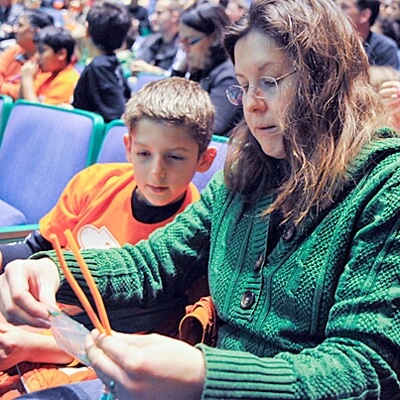News
Lindsey Smilack and her son, Edwin, of Cambridge fashioned DNA molecules from pipe cleaners at the SEAS Holiday Lecture. (Photo by Jon Chase, Harvard Staff Photographer.)
Walking through a sea of young students crowding the stage of Science Center B, Howard Stone neatly created order out of chaos, pairing children as he passed.
“We need an A here,” he called out. Stone is the Donald R. Dixon ’69 and Elizabeth W. Dixon Professor in Mechanical and Aerospace Engineering and chair of the Department of Mechanical and Aerospace Engineering at Princeton University. “You’re an A? OK, here’s a T. There you go. Who’s next?”
The exercise, pairing students who had been assigned letters representing the genetic code — A’s with T’s, and G’s with C’s — resulted in their creating a human double helix, neatly reflecting the complex sequencing that creates every living thing.
“Our goal today is to help convince you that the world is an amazing place,” Stone said, speaking to hundreds of community and family members from Cambridge, Boston, and the surrounding area at the annual School of Engineering and Applied Sciences (SEAS) holiday lecture on Saturday. “And that science and scientific ideas can help us understand so many things about the world.”
With the help of children in the audience, Stone and his colleagues explored the history and science of DNA in two lectures titled “DNA: A Detective Story.” Children helped scientists to separate out strawberry DNA, explored DNA sequences for hissing cockroaches and butterflies, learned how scientists cracked the universal code and structure of DNA, and, in the final demonstration, showed how DNA copied itself.
“It was wonderful,” said Mary Afari-Aikins, who brought her children John, 8, and Anneliese, 7, to the event. “It was so much more than I expected. This was our first time, and it’s a great opportunity. Everyone got to participate, and it excites them for their future.”
Read the entire article in the Harvard Gazette
Cutting-edge science delivered direct to your inbox.
Join the Harvard SEAS mailing list.
